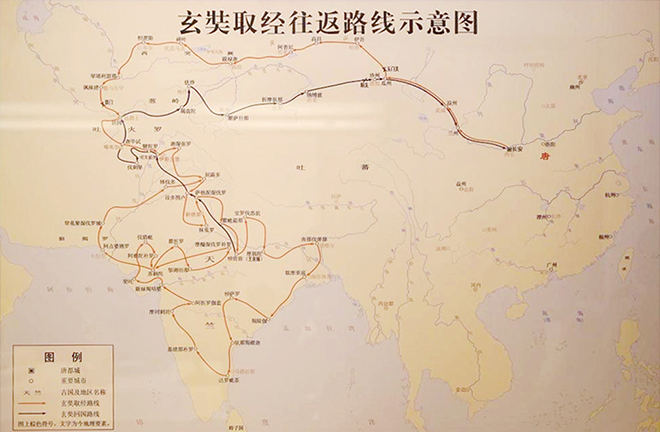Central Asian studies serve Belt and Road construction

The round-trip route of Xuanzang’s pilgrimage from Chang’an, capital of the Tang Dynasty, to India, displayed at the National Museum of China in Beijing Photo: Yang Lanlan/CSST
In ancient times, China and Central Asia collaborated in establishing the historic Silk Road. Nowadays, they carry on their future-oriented, in-depth cooperation under the Belt and Road Initiative (BRI). Deepening Central Asian studies is conducive to the flourishing of the BRI and the building of a closer China-Central Asia community with a shared future.
In this context, the Institute of Central Asian Studies at Northwest Normal University (NWNU), established in Lanzhou, Gansu Province, in April 2016, has been leveraging its geographical advantages in the golden section of the Silk Road, integrating internal and external research forces, and contributing to people-to-people exchanges between China and Central Asian countries in recent years.
Platform establishment
The Institute has published more than 60 high-quality research papers on Central Asian politics and law, Central Asian tourism, Dungan language and culture, and bilateral cultural exchanges and cooperation, while producing more than 20 academic publications and obtaining approval for over 30 research projects.
The academic journal Central Asian Studies Newsletter, the conference proceedings Belt and Road Studies (Lanzhou University Press), and The Collected Papers of Central Asian Studies (Gansu Cultural Press) serve as the main academic platforms sponsored by the Institute. Aiming to provide credible research consultation and serve Belt and Road construction, Central Asian Studies Newsletter regularly releases new developments of both the Institute and the academic community on Central Asia. As of now, the Institute has edited 14 issues, with distribution at over 200 universities and research institutions across more than 30 countries and regions, facilitating the dissemination of the latest academic achievements in Central Asian studies.
Under the framework of the University Alliance of the Belt and Road, “the International Forum on Humanitarian Exchanges and Cooperation between China and Central Asian Countries,” initiated by the Institute, has evolved into a jointly built collaborative international academic exchange platform. To date, six sessions of the Forum have been held in various locations including Bishkek, Kyrgyzstan; Dunhuang, China; Talas, Kazakhstan; Lanzhou, China; and Astana, Kazakhstan. These gatherings aim to explore reciprocal development opportunities and foster cultural and educational collaboration.
The Institute has also organized the translation and publication of law books from the five Central Asian countries. This initiative provides crucial legal support for Chinese enterprises seeking to invest and collaborate in Central Asian countries while cementing deep and extensive cultural ties.
Importance of Hexi Corridor
Speaking of the significance of the Hexi Corridor, Tian Shuru, NWNU vice president and director of the Institute, emphasized its pivotal role. Situated within the golden section of the ancient Silk Road, the Hexi Corridor boasts favorable geographical advantages and profound cultural heritage. It served as an outpost for China’s great unified dynasties to control the northwest frontier, the overland passage connecting China with the outside world, and an incubation base for the fusion of Chinese and other esteemed cultures. Historically, it played an indispensable role in maintaining national stability, ensuring border security, fostering ethnic integration, and facilitating exchanges between China and the West.
The Institute has been working hard to thoroughly tell the historical story of China-Central Asia civilizational exchanges based on Hexi Corridor studies. The project “Hexi Corridor and Central Asian Civilization,” with Tian as its chief expert, aims to investigate the formation and persistence of the geopolitical relations between the Hexi Corridor and Central Asia. Striving to solidify the cultural bonds between China and Central Asian countries, the project contributes wisdom to building the Belt and Road and forging a community with a shared future for mankind.
Ma Yufeng, executive editor-in-chief of Central Asian Studies Newsletter, highlighted that such projects systematically examine the historical interactions between the Hexi Corridor and Central Asian civilizations. They explore these interactions from the perspectives of national security, ethnic integration, cultural exchanges, inheritance of cultural heritage, and ecological resource protection, she added. This holistic approach implies academic significance for building a community with a shared future for mankind.
Throughout the process, scholars have consistently provided recommendations for enhancing governmental initiatives. Upon identifying specific issues related to the Hexi Corridor’s post stations, Ma proposed that the Gansu Provincial Bureau of Cultural Relics take the lead in organizing research and cultural relic protection teams. Meanwhile, cultural relics institutions need to establish a scientific management system and enhance the technological and preventive protection of the post sites, thereby ensuring their preservation and cultural influence.
Looking ahead, the Institute is tasked with intensifying research on traditional issues such as Central Asian Dungan history, language, and literature, the construction of the Dungan corpus, the education of Chinese students in Central Asia, cross-border tourism cooperation, as well as bilateral cooperation in economy and trade, education, and health care, Tian continued. Greater efforts should also be made to delve into new themes such as the Silk Road of Culture, the Health Silk Road, the Silk Road for Youth, the Silk Road of Educational Cooperation, and the Digital Silk Road, bringing forth deeper and broader people-to-people exchanges between China and Central Asian countries.
Edited by YANG LANLAN

 PRINT
PRINT CLOSE
CLOSE